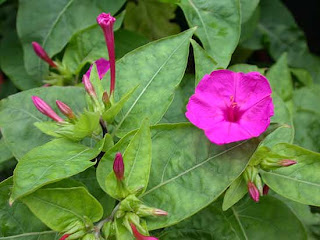





Clerodendrum thomsoniae is also known as bleeding heart or glory bower. It is a twining evergreen shrub that is native to Western Central Africa. Leaves are evergreen, simple, opposite, glabrous, entire. They are up to 6 in (15 cm) long and have strong veins. Flowers appear mainly in summer. They are grouped in axillary or terminal panicles. Flowers have a white calyx, a scarlet-red corolla, and prominent stamens and style. This plant produces inedible black and orange-red berries as fruit. Green at first, they blacken as they ripen. Then, they split open from the top to the bottom to present a bright orange fleshy lining that contains four black seeds. Blooms mostly from April to October-November in natural conditions of tropical climate. The plant drops some leaves (not all of them) in winter, and has some flowers (not much) even during the winter time. As long as you provide lots of light to it, it'll bloom most of the time.
This Clerodendrum is often sold as a house plant. However, it is a fast growing and vigorous plant that is best grown outdoors in warm climates, or under glass elsewhere. This plant needs direct sun in order to bloom well; a sunny window may be sufficient if you don't move the container outdoors for the season. Water and fertilize regularly when actively growing. Use a rich, but well-drained potting medium and keep moist but not wet. Since C. thomsoniae blooms on new growth, it is best to cut the plant back after blooming. Thin out old overcrowded shoots and any other far-reaching growth to keep the vine in bounds - don't be afraid to prune severely. Bleeding heart vine has few pests, but mealybugs and spider mites can occasionally be problems.
Although it is root hardy to zone 9, it really is a tropical plant and does need protection from freezing. If grown outdoors, move inside when temperatures fall below 45ºF. When temperatures are cool enough (even indoors), the plant will shed its leaves. New leaves will resprout from the roots or what looks like dead wood in spring. If it does go dormant in the winter, withhold water until the new growth starts (water just enough to keep the soil from drying out and don't fertilize).
Bleeding heart vine is easy to propagate by cuttings or serpentine layering. Semi-ripe tip cuttings taken in late spring or late summer can be rooted in water or moist sand or other medium. Roots should appear in about 2 weeks. Seeds can also be planted in spring.















































